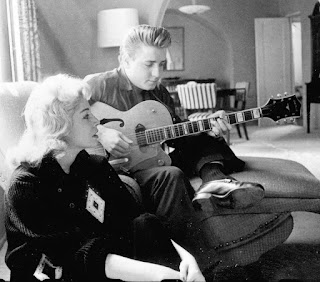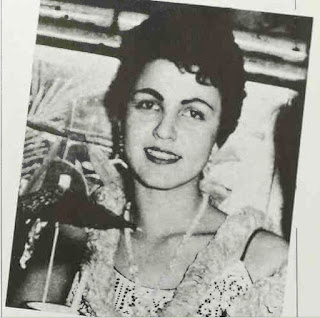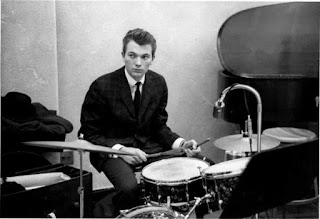"Meet Me at the River, Buddy Holly" (2013) by Bob Lapham is a novel, except the prologue and Chapter 13 titled Buddy Holly and the Picks are true; throughout he book the name of the guy I call Trebor Maple. Trebor Maple is Robert Lapham spelled phonetically backward. That’s me. Bob Lapham, the last surviving member of the pop-R&R trio that was Buddy’s primary vocal backup group on the original Crickets songs, mainly an album considered one of early rock ‘n’ roll’s classics that won the 1958 Billboard best new vocal group award.
Treb lies in the back seat. His eyes close. Immediately he shudders, blinking in the semi-darkness. He is certain he can see Buddy Holly, unsmiling as he stares straight ahead, seemingly oblivious. Treb fends off encroaching sleep, surprised to see the rock ‘n’ roll figure unchanged in his wide-awake vision and wondering if he should initiate conversation. Louise looks back, over the seat. “I’m talking to Buddy,” he whines. “Holly? Be sure to tell him I always liked Elvis better.” Treb concentrates, deciding that if this is a valid vision, he can communicate closer to a spiritual level. He can’t see Buddy’s lips move, but he hears, as plain as the whirring Chevrolet differential just below him. “It doesn’t matter anymore…” Treb replies¨: “You mean, after all these years, you’re gonna answer me in song titles? you rank second only to Elvis in the list of influential rock ‘n’ roll pioneers!”
Treb is really feeling sorry for himself now. The old recording sessions at Norman Petty’s studio in Clovis, New Mexico used to take their toll on him, both physically and mentally. “So, get ready to meet me at the river, Buddy Holly.” “What?” Louise Maple asks. But her husband has fallen into the deepest sleep he’s ever experienced. “Your father is in la-la land,” she tells her daughter, taking a drag on her cigarette. Being a Texas Tech student for four and a half years, with a journalism degree, as well as being well versed in the strange nature of Lubbock, he had got a kick out of remembering the night a teenaged Buddy Holly lost his virginity in the back seat of a car parked on a dirt road that paralleled an irrigation ditch in a South Plains cotton field.
Coral was a subsidiary of Decca Records, which originally had Buddy under contract for a horribly produced country album recorded in Nashville earlier. Decca gave approval to let Buddy try rock ‘n’ roll stuff with Coral, and good riddance, it seemed was their attitude in the Nashville country music end of the label. But not That’ll be the Day, which had been on the Nashville album. As I understood the situation from studio gossip in Clovis, Coral was starting to spread its independent wings. It had latched onto an old abandoned label from the 1920s and ‘30s. Brunswick Records was picking up offbeat releases. Somebody in Coral’s office, upon Norman Petty’s prompting, decided to cover Decca’s That’ll Be the Day by Buddy Holly on Brunswick, with the newly formed Crickets as the artists, when Decca and the record-buying public got around to figuring out the end play.
The result was the birth of a rock ‘n’ roll legend with That’ll Be the Day, prompting Brunswick to hastily make plans to put out the Chirping Crickets album, all while Buddy Holly’s separate rock ‘n’ roll solo career was taking off on Coral with Peggy Sue and Everyday. “When Norman re-recorded That’ll Be the Day in his Nor Va Jak Studio in Clovis, he lowered the key for Buddy that Decca had produced. For that little production suggestion, Norman cut himself in on songwriting credit, sharing three ways with Allison and Buddy, where Buddy had written the song that Decca recorded. It must’ve been a nightmare to sort out, money-wise, but in later years royalties from that one song alone, a classic that would be covered by dozens of artists through the decades – notably Linda Rondstadt – provided hundreds of thousands of dollars for the three shareholders.
Norman’s soon-dominant cutting himself in for credit as songwriter was born with That’ll Be the Day, I believe. But it sure didn’t end there. Also, he had already formed his own publishing stable, working through Southern Music Publishing in Nashville. So if you came to Clovis to peddle a song, chances are Petty would agree, if he could publish it and record it through Nor Va Jak. And if he could get it recorded, well it seemed only fair to him that he be cut in for songwriting credit. That’s where the real money in music recording came. Royalties for air play made a lot of non-performing songwriters very rich. This started in the Big Band era, but the practice really got sophisticated when rock ‘n’ roll became a producer’s and publisher’s paradise.” True Love Ways proved to be perhaps the best ballad the Picks ever did with Holly.
Listening to Trebor Maple tell about his and co-Picks Bill and John Pickering's contribution to the Holly legend during the summer and fall of 1957.--- The early world of rock ‘n’ roll had been littered with hastily forgottens; those performers who had hit quickly, then took express trips to permanent obscurity. Nino and the Ebb Tides (Franny Franny), Patience and Prudence (Tonight You Belong to Me), Rosie and the Originals (Angel Baby), John D. Loudermilk (Language of Love), and Paul and Paula (Hey Paula). Even Kenneth Copeland had enjoyed a stand-alone teeny-bopper hit in the fifties, but a huge following as a TV evangelist years later kept him far from becoming obscure.
Buddy was better off, but only temporarily. That’ll Be the Day, written by him, was strictly a Crickets hit. Two months later, on a companion label thanks to a bit of managerial chicanery by their manager-producer, Norman Petty, Peggy Sue (the greatest rock'n'roll anthem) introduced the world to Buddy Holly, a world that quickly figured out the same guy was featured vocalist on both records. The Crickets seemingly were a vocal group that sang and played with Buddy. However, with one exception involving Niki Sullivan, they were not singers. Two big hits in a period of three or so months, and no place to go. Buddy, Allison, young 17-year-old standup bass player Joe B. Mauldin, and rhythm guitar Niki Sullivan were quickly on the road, doing one-nighters.
Petty and his wife, Vi, had all but abandoned their modest regional enterprise of playing for dances in Lubbock, Amarillo, and elsewhere along the Texas-New Mexico border. Clovis, that large stucco two-story building next to the studio housed an apartment where Norman and Vi lived upstairs. Never far out of sight was Norma Jean Berry. She’d slip in and out of the studio. I got the idea early on that Norma Jean was a glorified housekeeper. But she never did any housework that I could see. Norman was a very secretive guy. Intermittent rumour had it that Vi Petty and Norma Jean carried on a lesbian relationship; that Norma Jean and Petty had once had an affair; even that the three participated in troilistic sexual acts. The truth appears to have been that all three, for different reasons, were virtually sexless, and that Norma Jean clung to the Pettys as her surrogate family.
The Crickets had helped Norman install speakers at one end of the garage, and microphones at the other, to make the echo effect that was remarkable, especially for a home-made fixture. Phil Spector later told an interviewer that his “Wall of Sound” was inspired by Norman Petty’s Clovis sound. Particularly what the “Crickets” (actually the Picks, both as arrangers and vocalists) did on Holly songs such as Oh Boy! It's March, 1957: Petty usually worked best at night, in the wee hours, when huge trucks or a train were less likely to rumble by and be picked up on tape in the not-completely-soundproof studio. The Pickerings would go out and have hamburgers with Buddy and the Crickets together in early morning hours, after an all-night session.
Holly’s bridge between obscurity and certain stardom (Peggy Sue) was in the planning stages. And eventually, rock ‘n’ roll hall of fame status. Buddy and the Crickets, deservedly so. But not the Picks. Treb, John and Bill’s lone claim to recognized achievement was being named to the little-known Rockabilly Hall of Fame in the 1990s. At any rate, Oh Boy! took off when released in October. It anchored The Chirping Crickets album that emerged then too, with the Picks backgrounding on nine of the 12 songs. Included were the ultimately charted singles Maybe Baby and Tell Me How. Treb told Brad that his favorite among the throw-away songs was An Empty Cup and a Broken Date, a real weeper, written by Roy Orbison. Orbison, tiring of Sun Records’ facilities, was beginning to experiment with the Clovis sound.
On a hot day in August, 1957, in the tiny six-by-eight foot control room at Norman’s studio, we were prepared to listen to a playback of the final tape version of Oh Boy!, which Buddy and the band hadn’t heard yet. The Crickets were dressed almost identically, in faded blue jeans and white T shirts, and wearing penny loafers. Buddy was wearing the same attire, except for natural-leather moccasins on his feet. Chances were, he had made them himself. The sudden stars seemed unaffected by their rise to fame. They were a bashful sort, according to John Pickering’s assessment. They have been called "the true gentlemen of the rock 'n' roll" or "the good boys of rock 'n' roll".
Buddy listened intently until the all the “dum-de-dum-dum—oh boys” had faded. Then he beamed. “You guys did it!” he exclaimed, going to each of the Picks and shaking their hands. To Buddy, Maple had been the bumbling, stumbling and often off-key foulup of the several sessions they had worked together. Now, Holly was ecstatic and animated. “You guys were really great!” Holly said. “We got ourselves another hit!” Later in the year, Holly would confide to an interviewer that he liked Oh Boy! more than his signature song, That’ll Be the Day. “That’s as good as anything Pat Boone ever did,” John Pickering offered, after Oh Boy! had been played again. “Pat BOONE!?” Buddy shot back. “Man, Pat Boone ought to be standing in the background, doing doo-wahs!” John pretended to take offense. “Thanks a LOT, Buddy.” The rest of the room erupted into laughter. All except Holly. He was concerned that his remark, intended to put down Boone, had been misinterpreted by the Picks. “I didn’t mean it that way,” he said. Buddy would be the first self-deprecating rock-star.
From that time on, around the studio the Picks were dubbed The Doo-Wah Boys. Soon after Oh Boy! was released, Buddy and the Crickets were booked on The Ed Sullivan Show. American audiences who saw Buddy and the Crickets never seemed to mind that half the songs they sang didn’t sound like the record i.e. didn’t have vocal background. It wouldn’t be until their tour of England that fans began demanding to know what was going on here. They found out, thanks to John Beecher. So to this day, the Picks are virtually unknown in America, in reference to Holly. But England’s more loyal fans are quite familiar with them. Then, disappointment riddled the Picks’ euphoria. They came to the studio a week or so prior to “the big shew,” and Norman had a telegram from Sullivan to show them. “Don’t bring the other boys unless they belong to the union,” Sullivan said. “We’re making money, but we can’t afford that. Not yet,” penny-pinching Petty told the Picks with a frown. It would cost about five-hundred dollars apiece, he claimed. None of the Picks could afford it either. Buddy was disappointed as much as they, Treb said. Norman retained control of all money coming in.
We knew Norman was lying. But the darker sides to his personality began turning the Camelot in Clovis into failure, shortly after that storied summer of 1957. Buddy got married to Maria Elena, against the wishes of Norman, who had assumed near-parental attitudes with the Crickets. He had an even tighter hold on their money. After Buddy’s marriage, he and the Crickets began drifting apart. Allison and Mauldin tried different sidemen, and returned to Clovis. Meanwhile, Buddy was in the process of severing ties with Norman and was recording in New York. His actions, it was reported, led Petty to angrily tell one of the Crickets, “Let him try! I’ll starve him out!” Buddy was threatening legal action to get to what he claimed was considerable money owed him.
Both Pickerings got to know Maria Elena fairly well, particularly John (who, at the request of Buddy’s family, sang two Baptist hymns during Buddy’s funeral). Treb said he didn’t meet Buddy’s widow until they had lunch together in 1999. “We told each other stories about Norman Petty,” Treb said. “She loved it.” Buddy was on the low-paying Winter Dance Party tour because he was broke, with tens of thousands of dollars belonging to him lying unattainable in a Clovis bank. “Buddy’s in his room,” Mrs. Holley told Treb. “The last time I saw him, Buddy wore a black leather jacket over a white T-shirt. He had black motorcycle boots over tailored Levis. He was slowly combing his coal-black hair. He looked at me. He wasn’t wearing his horned-rim glasses at the moment.”
“I had one more meeting with Petty, almost thirty years later. That was in a Lubbock hospital, a month before Norman died it 1984. Bill Pickering was living with his mother in Lubbock, and the first Buddy Holly & the Picks compilation album was about to be pressed. I did comment about all the many people Norman’s money-hungry ways had hurt; perhaps even killed, in Buddy’s case. How many dreams he had not respected enough to give a fair shake.”
Tommy Allsup: Buddy Holly was very likable. Very confident. He was more reserved off stage than people would think. He was truly a creative genius, not just as a songwriter or performer, but in the way he approached making records and doing the music business. ("The Flip of a Coin", 2010)



































































